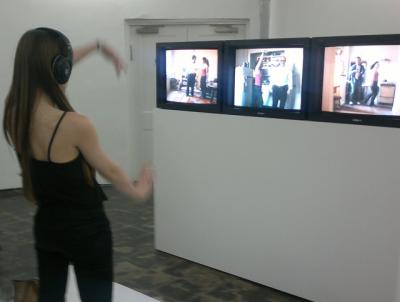Review – On first appearances, Laurel Nakadate is an artist fascinated by sexual violence and the fetishes of men. The body of work on display at this US artist’s first solo UK show – which includes a video piece shot with male strangers picked up at truck stops and gas stations, who play strip poker with the artist or follow her silently as she walks alone at night – is awkward viewing, apparently forcing us to see Nakadate as men at their most unpleasant see her; as a vessel for sordid desire.
But to characterise Nakadate’s work as a feminist-style polemic on rape is to miss the point. Granted, this is dark and seedy stuff that, in the words of one viewer at last night’s opening, ‘does not reflect on men very well’. One film, for instance, depicts the artist acting out ‘love scenes with an absent, invisible lover’: in energetically simulating one half of fornication, flung about like a rag doll, Nakadate seemingly exemplifies Andrea Dwrokin’s classic argument – that ‘violation is a synonym for intercourse’, sex being an act of aggression in which the man looks only to satisfying himself. Exhibited alongside the piece ‘365 Days: A Catalogue of Tears’ – photographs of a performance in which the artist photographed herself crying everyday for one year –, the words ‘victim’ and ‘exploitation’ cannot but be on the tip of every viewer’s tongue.
Yet, in the face of such gloom, Nakadate’s work is meant to be – and often genuinely is –, in equal measure, funny. In a performance, in which she travelled across America in order to recreate crime scenes, she translates the horrors of murder into extreme and infectiously hilarious slapstick. While one set of viewers watch in shock at the footage of Nakadate with a plastic bag over her head, legs twitching, another set laugh out loud at the sequence in which she melodramatically ‘shoots’ herself with a plastic cowboy’s pistol, spitting fake blood, and coo ‘she’s so funny. Isn’t she funny?’
Her pieces relating to the life and times of Britney Spears (an enduring point of interest for the artist) are even heart-warming (!). In an attempt ‘to exorcise Britney Spears’s sadness’, for instance, Nakadate performed a dance on the Salt Flats outside of Salt Lake City, Utah. Yes, this is a joke, relishing the naive absurdity of such an aspiration: but, like all the pieces in the show, it remains double-edged, the work being the product of a deep empathy on Nakadate’s part for Spears’ very real plight – an authentic effort ‘to spare her from the downward spiral that the media was portraying’, and undertaken on the rationale that, through performing a dance, ‘I might have brought her relief’.
It is necessary to reassess one’s immediate reaction to Nakadate’s work, especially in relation to those with a ‘cast of strangers’ – men met by chance or via classified adverts on the internet. Rather than entering into relationships with these characters as reprehensible perverts, Nakadate interacts with them as human beings, reaching out to them and offering redemption. The rampentness of their desire is assumed by the viewer rather than evidenced in their actions. The man who asked Nakadate to be his life model, for example, is true to his word, and painstakingly draws the artist instead of groping her; we, the viewers, are the ones who are not playing fairly, the assumption of an ulterior motive being the product of prejudice. Nakadate asks us to suspend our judgement on these individuals, and to recognise our shared humanity. This is rehabilitation, not condemnation.
The inclusive ethos of Nakadate’s practice is again demonstrated in the exhibition’s centrepiece – a dance floor for us to throw shapes as we watch her rendition of Britney Spears’s ‘Oops!… I Did it Again’, performed with three men that she met by chance in New Haven, Connecticut. With Nakadate having prepared for the performance by watching MTV eight hours a day, for seven days, and memorising Spears’s original choreography, the men appear painfully clumsy as they try to follow her, one even standing dead still, awkward, paralysed. It is very suddenly that we, watching Nakadate pirouette, – comparatively clumsy, awkward, and perhaps even paralysed on the gallery’s make-shift dance floor – see our own reflection.
This Latest Exhibition @ 176 The Zabludowicz Collection London Runs until 11 December
Words/ Photo Thomas Keane © 2011 ArtLyst

